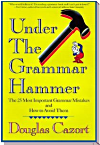

| Book of the Month | ||
 |
Under the Grammar Hammer |  |
Publisher: Lowell House
Author: Douglas Cazort
$9.95
ISBN 0-929923-75-8
Have you ever heard fo the 80/20 rule? This is a rule that states that out of any set of a hundred problems, eighty of them will have the same twenty causes. So if you write a letter that contains one hundred grammar mistakes, eighty of these mistakes will be caused by the same twenty problems with your grammar. (For example 'He wroted the letter and posten it' contains two mistakes and the one cause - misunderstanding of past tenses.) The author has therefore taken an original approach with this book. As he says, it is not a grammar book, because there are hundreds of grammar books already available. Instead he gives a list of the twenty most common causes of grammatical errors, and describes how to spot them when they appear and how to correct them afterwards. These twenty most common errors were identified in a study in 1991, along with a further five errors which are less common. However, although these five errors are less common, they are important, as the study identified them as the grammatical errors which most annoyed readers and caused them to have a lower opinion of the writer. And the Grammar Hammer? This is because the author compares writing English with hammering a nail into wood - if you swing your hammer badly you end up hurting your thumb; and if you write a sentence badly, you end up damaging the image other people have of you.
Given the idea of the book, one would expect twenty-five chapters, twenty dealing with the most common errors, and five dealing with the uncommon but serious errors. In fact this does not happen, not least because this is a very short book of only 110 pages. In fact this book is even shorter than that, because every second page contains a large black-and-white line drawing which illustrates the ideas in the text and takes up space. Even with such limited space, the author still spends his first chapter explaining the reasons why he has written the book, what it is about and how to use it. The final chapter is also not about the twenty-five grammar errors, but as the title asks, 'Where do we go from here?'. This describes various ways that a person worried about his poor grammar can improve it. However, one should be cautious about the drastic solution given in the introduction which recommends 'If you can't spell, marry someone who can.' The humourous approach of this 'solution' is typical of the book, which deals with grammar in a light-hearted and very readable manner.
By far the longest chapter in the book is Chapter 6. This takes up almost half of the book and is the key chapter - the twenty major grammar mistakes. These are introduced with an example of the error - called a 'bad swing' because if it was a hammer, the mistake would hit your thumb - and a 'direct hit', an example which which 'hits the nail on the head' that is; gives the correct form. The errors described are those which every English teacher has met - the comma splice, the misused apostrophe, subject-verb disagreement, bad pronoun cases, erroneous capitalization, and well, nineteen others. The book not only tells of these errors but in later chapters suggests ways of eliminating them. For example, the author recommends that one should not attempt to produce perfectly-crafted sentences at the first try. Instead, write what you want to say, then, with this book in hand, go through what you have written and remove the mistakes.
Who is this book for? The book is written for native speakers of American English. However, it is also very suitable for students of English as a foreign language, especially if these students need to write in English. The book assumes at least a working knowledge of English, so it is for correcting bad habits than teaching new grammar. Although British and American English disagree on some vocabulary and spelling, the two forms of the language have the same grammar, so this book can be used by speakers of British English. Because it is small, light and easy to read, this is a book which can be put into a backpack or briefcase and studied whenever the reader has a few minutes to kill.
Verdict: Useful and very readable.
Assessment 8/10